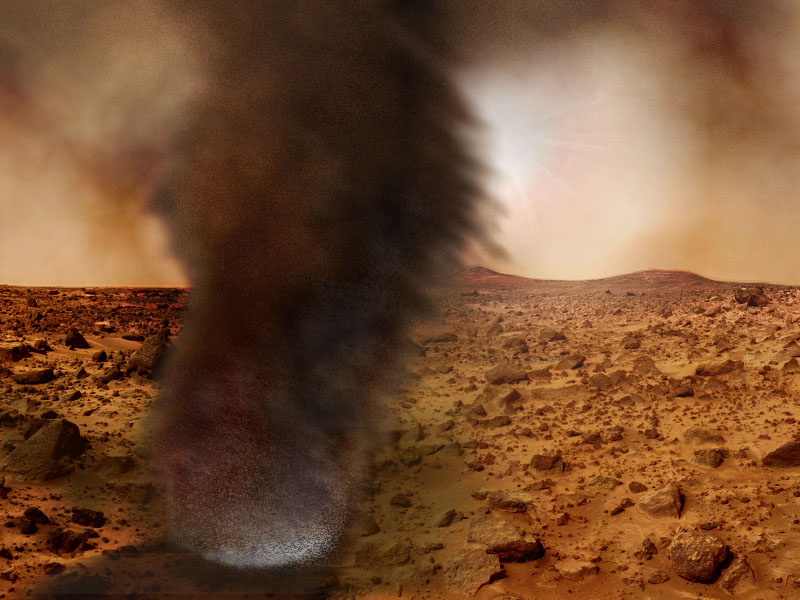
home •
about •
essential guide •
picture of the day •
thunderblogs •
news •
multimedia •
predictions •
products •
get involved •
contact

Credit: University of Michigan
pic of the day
archive
subject index
abstract
archive
Links:
Society for
Interdisciplinary
Studies
Mar 21, 2005
Electric Dust Devils on Mars
Giant columns of whirling dust on Mars add new surprises in planetary exploration. Experts now agree that analogous “dust devils” on Earth contain powerful electric fields.
In the larger scheme of things, dust devils on Earth have always been treated as trivial phenomena. But this perception has changed with recent discoveries by investigators in Arizona and Nevada. They found that dust devils have a strong electric field, often exceeding 4,000 volts per meter.
The discovery came as a surprise. Prior thermal and mechanical models of dust devils had predicted no electric fields. But ironically, it was discoveries on the planet Mars that provoked a reconsideration of atmospheric vortices on earth. On Mars, “dust devils” much larger than terrestrial tornadoes sporadically rake across the surface, achieving things that traditional meteorology considered impossible in the nearly airless Martian environment. The tracks of these Everest-sized “whirlwinds” speak for high-energy activity never imagined, inscribing the Martian surface with their darkened tracks. (See Picture of the Day: Europa and Mars
Atmospheric density on Mars is only one percent that of Earth. How could a Martian “wind” excavate soil with sufficient energy to leave extensive tracks clearly visible from space? Of course, the same question is posed by the planet’s global dust storms, these having been observed for several decades.
In July, 1999, Wallace Thornhill wrote “The 5 mile high dust devils on Mars and the global Martian dust storms are, I believe, a manifestation of electric discharges on Mars.” And more recently, he wrote “Make no mistake, the Martian dust devils are tornadoes that dwarf their earthly counterpart… Clouds are not required to generate them. They are an atmospheric electric discharge phenomenon”.
Today, interest in the electrical nature of Martian dust devils is growing rapidly. In a report in Astrobiology Magazine, Dr. William Farrell of NASA's Goddard Space Flight Center reports: “If martian dust devils are highly electrified, as our research suggests, they might give rise to increased discharging or arcing in the low-pressure Martian atmosphere”. According to Thornhill, such arcing in the rarified atmosphere of Mars would have the appearance of a glow discharge, not unlike that of a lightning “sprite” above terrestrial thunderstorms.
Our picture above is a University of Michigan artist’s impression of an electrified Martian “dust devil”. Did the artist intuitively include a glow discharge near its base? In the Global Surveyor pictures of these Martian dust columns, the eerie glow is a dramatic contrast to the darkened dust they lift into the atmosphere. (We’ve placed a picture here).
To see the electrical nature of these towering vortices is to answer the question we posed in our last Picture of the Day. Why does the Martian surface present both dark and light streaks, just as we see on Jupiter’s moon Europa? Experiments with laboratory arcs have shown that the discharges will “burn” soil, leaving a darkened look Though enigmatic to planetary scientists, such darkening is evident across vast regions of Mars. It is especially concentrated in regions of heavy dust devil tracks, typically appearing amid dense populations of small dark spots. In those regions where electric activity has burnt the soil directly, or where darkened material was raised into the atmosphere and then drifted back to the surface, the layer of such material is apparently quite thin. It is thus easy to imagine that when lower energy dust devils have subsequently moved across such surfaces, they removed the layer of dark material and exposed the original lighter soil below.
Unfortunately, even with the new interest in electrified whirlwinds on Mars, most discussion still draws on old thermal and mechanical concepts of atmospheric “whirlwinds”, without regard to the role of larger electric fields in their generation. Most of the “new” theoretical models of electrified dust devils, for example, have not broken out of the earlier paradigm. To get the electric field, the theorists believe they have to first “separate charge”; and that requires energetic movement and collisions of both large and small soil particles. In their collisions, the larger particles become positively charged and the smaller become negatively charged. Then the power of the wind separates the particles into regions of different particle size, creating an electric field.
But in the near vacuum of Mars’ atmosphere, how were the larger grains of soil raised miles into the sky in the first place, with a force sufficient to generate the apparent high voltages? In the electric model, no local dynamo is required for charge separation. Charge separation already exists in the atmosphere. Without Earth’s storm clouds to lower charge to ground in the form of lightning, the discharges on Mars take a towering tornadic form. The larger interplanetary electrical circuitry is the true driver of the whirlwind, just as it drives the global dust storms on Mars, and just as it drives weather systems on Earth. If this is true, then the power of Martian “dust devils” can teach us much about the behavior of electricity in the solar system.
See tomorrow’s Picture of the Day, “Dust Devils—or Tornadoes?”
See also:
Electric Dust Devils
See also:
Tornadoes as Electric Discharge
EXECUTIVE EDITORS:
David Talbott, Wallace Thornhill
MANAGING EDITOR: Amy Acheson
CONTRIBUTING EDITORS: Mel Acheson, Michael Armstrong, Dwardu Cardona,
Ev Cochrane, C.J. Ransom, Don Scott, Rens van der Sluijs, Ian Tresman
WEBMASTER: Michael Armstrong
Copyright 2005: thunderbolts.info